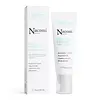What's inside
What's inside
 Key Ingredients
Key Ingredients

 Benefits
Benefits

 Concerns
Concerns

 Ingredients Side-by-side
Ingredients Side-by-side

Vaccinium Angustifolium Fruit Extract
Skin ProtectingGlycerin
HumectantWater
Skin ConditioningDimethicone
Emollient1,2-Hexanediol
Skin ConditioningDiglycerin
HumectantMethylpropanediol
SolventPEG/PPG-17/6 Copolymer
SolventBetaine
HumectantTrisiloxane
Skin ConditioningBis-PEG-18 Methyl Ether Dimethyl Silane
EmollientAcrylates/C10-30 Alkyl Acrylate Crosspolymer
Emulsion StabilisingTromethamine
BufferingDimethicone/Vinyl Dimethicone Crosspolymer
Skin ConditioningPanthenol
Skin ConditioningPEG-6 Methyl Ether
SolventEthylhexylglycerin
Skin ConditioningPolyglyceryl-10 Laurate
Skin ConditioningXanthan Gum
EmulsifyingBiosaccharide Gum-1
HumectantIsoceteth-10
EmulsifyingIsoceteth-25
EmulsifyingSodium Hyaluronate
HumectantBHT
AntioxidantCoco-Caprylate/Caprate
EmollientPrunus Armeniaca Kernel Oil
MaskingVitis Vinifera Seed Oil
EmollientCitrus Paradisi Seed Oil
PerfumingMangifera Indica Seed Oil
EmollientPunica Granatum Seed Oil
EmollientSolanum Lycopersicum Seed Oil
EmollientTocopherol
AntioxidantDisodium EDTA
Phenoxyethanol
PreservativeCI 60730
Cosmetic ColorantParfum
MaskingVaccinium Angustifolium Fruit Extract, Glycerin, Water, Dimethicone, 1,2-Hexanediol, Diglycerin, Methylpropanediol, PEG/PPG-17/6 Copolymer, Betaine, Trisiloxane, Bis-PEG-18 Methyl Ether Dimethyl Silane, Acrylates/C10-30 Alkyl Acrylate Crosspolymer, Tromethamine, Dimethicone/Vinyl Dimethicone Crosspolymer, Panthenol, PEG-6 Methyl Ether, Ethylhexylglycerin, Polyglyceryl-10 Laurate, Xanthan Gum, Biosaccharide Gum-1, Isoceteth-10, Isoceteth-25, Sodium Hyaluronate, BHT, Coco-Caprylate/Caprate, Prunus Armeniaca Kernel Oil, Vitis Vinifera Seed Oil, Citrus Paradisi Seed Oil, Mangifera Indica Seed Oil, Punica Granatum Seed Oil, Solanum Lycopersicum Seed Oil, Tocopherol, Disodium EDTA, Phenoxyethanol, CI 60730, Parfum
Water
Skin ConditioningPropanediol
SolventCetyl Alcohol
EmollientPersea Gratissima Oil
Skin ConditioningCaprylic/Capric Triglyceride
MaskingCetearyl Alcohol
EmollientGlyceryl Stearate
EmollientButyrospermum Parkii Butter
Skin ConditioningNiacinamide
SmoothingPrunus Amygdalus Dulcis Oil
Skin ConditioningShorea Stenoptera Seed Butter
EmollientTocopheryl Acetate
AntioxidantSorbitol
HumectantStearic Acid
CleansingAdansonia Digitata Seed Oil
EmollientSerine
MaskingAlgin
MaskingPullulan
Trehalose
HumectantUrea
BufferingAllantoin
Skin ConditioningOlea Europaea Fruit Oil
MaskingAscorbyl Palmitate
AntioxidantPhytosterols
Skin ConditioningHyaluronic Acid
HumectantSodium Hyaluronate
HumectantHydrolyzed Hyaluronic Acid
HumectantSodium Hyaluronate Crosspolymer
HumectantHydrolyzed Glycosaminoglycans
HumectantLactic Acid
BufferingGlycerin
HumectantEthylhexylglycerin
Skin ConditioningRaspberry Ketone
MaskingSorbitan Oleate
EmulsifyingBenzyl Glycol
SolventCaprylyl Glycol
EmollientDisodium Phosphate
BufferingPolyglyceryl-3 PCA
EmollientPentylene Glycol
Skin ConditioningGlyceryl Polyacrylate
Parfum
MaskingPotassium Phosphate
BufferingSodium Lauroyl Glutamate
Dehydroacetic Acid
PreservativeBenzyl Alcohol
PerfumingWater, Propanediol, Cetyl Alcohol, Persea Gratissima Oil, Caprylic/Capric Triglyceride, Cetearyl Alcohol, Glyceryl Stearate, Butyrospermum Parkii Butter, Niacinamide, Prunus Amygdalus Dulcis Oil, Shorea Stenoptera Seed Butter, Tocopheryl Acetate, Sorbitol, Stearic Acid, Adansonia Digitata Seed Oil, Serine, Algin, Pullulan, Trehalose, Urea, Allantoin, Olea Europaea Fruit Oil, Ascorbyl Palmitate, Phytosterols, Hyaluronic Acid, Sodium Hyaluronate, Hydrolyzed Hyaluronic Acid, Sodium Hyaluronate Crosspolymer, Hydrolyzed Glycosaminoglycans, Lactic Acid, Glycerin, Ethylhexylglycerin, Raspberry Ketone, Sorbitan Oleate, Benzyl Glycol, Caprylyl Glycol, Disodium Phosphate, Polyglyceryl-3 PCA, Pentylene Glycol, Glyceryl Polyacrylate, Parfum, Potassium Phosphate, Sodium Lauroyl Glutamate, Dehydroacetic Acid, Benzyl Alcohol
 Reviews
Reviews

Ingredients Explained
These ingredients are found in both products.
Ingredients higher up in an ingredient list are typically present in a larger amount.
Ethylhexylglycerin (we can't pronounce this either) is commonly used as a preservative and skin softener. It is derived from glyceryl.
You might see Ethylhexylglycerin often paired with other preservatives such as phenoxyethanol. Ethylhexylglycerin has been found to increase the effectiveness of these other preservatives.
Glycerin is already naturally found in your skin. It helps moisturize and protect your skin.
A study from 2016 found glycerin to be more effective as a humectant than AHAs and hyaluronic acid.
As a humectant, it helps the skin stay hydrated by pulling moisture to your skin. The low molecular weight of glycerin allows it to pull moisture into the deeper layers of your skin.
Hydrated skin improves your skin barrier; Your skin barrier helps protect against irritants and bacteria.
Glycerin has also been found to have antimicrobial and antiviral properties. Due to these properties, glycerin is often used in wound and burn treatments.
In cosmetics, glycerin is usually derived from plants such as soybean or palm. However, it can also be sourced from animals, such as tallow or animal fat.
This ingredient is organic, colorless, odorless, and non-toxic.
Glycerin is the name for this ingredient in American English. British English uses Glycerol/Glycerine.
Learn more about GlycerinParfum is a catch-all term for an ingredient or more that is used to give a scent to products.
Also called "fragrance", this ingredient can be a blend of hundreds of chemicals or plant oils. This means every product with "fragrance" or "parfum" in the ingredients list is a different mixture.
For instance, Habanolide is a proprietary trade name for a specific aroma chemical. When used as a fragrance ingredient in cosmetics, most aroma chemicals fall under the broad labeling category of “FRAGRANCE” or “PARFUM” according to EU and US regulations.
The term 'parfum' or 'fragrance' is not regulated in many countries. In many cases, it is up to the brand to define this term.
For instance, many brands choose to label themselves as "fragrance-free" because they are not using synthetic fragrances. However, their products may still contain ingredients such as essential oils that are considered a fragrance by INCI standards.
One example is Calendula flower extract. Calendula is an essential oil that still imparts a scent or 'fragrance'.
Depending on the blend, the ingredients in the mixture can cause allergies and sensitivities on the skin. Some ingredients that are known EU allergens include linalool and citronellol.
Parfum can also be used to mask or cover an unpleasant scent.
The bottom line is: not all fragrances/parfum/ingredients are created equally. If you are worried about fragrances, we recommend taking a closer look at an ingredient. And of course, we always recommend speaking with a professional.
Learn more about ParfumSodium Hyaluronate is hyaluronic acid's salt form. It is commonly derived from the sodium salt of hyaluronic acid.
Like hyaluronic acid, it is great at holding water and acts as a humectant. This makes it a great skin hydrating ingredient.
Sodium Hyaluronate is naturally occurring in our bodies and is mostly found in eye fluid and joints.
These are some other common types of Hyaluronic Acid:
Learn more about Sodium HyaluronateWater. It's the most common cosmetic ingredient of all. You'll usually see it at the top of ingredient lists, meaning that it makes up the largest part of the product.
So why is it so popular? Water most often acts as a solvent - this means that it helps dissolve other ingredients into the formulation.
You'll also recognize water as that liquid we all need to stay alive. If you see this, drink a glass of water. Stay hydrated!
Learn more about Water